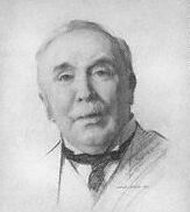Henry Campbell-Bannerman
 | |
| Data i miejsce urodzenia | |
|---|---|
| Data i miejsce śmierci | |
| Premier Wielkiej Brytanii | |
| Okres | od 5 grudnia 1905 |
| Przynależność polityczna | |
| Poprzednik | |
| Następca | |
| Odznaczenia | |
Henry Campbell-Bannerman (ur. 7 września 1836 w Glasgow, zm. 22 kwietnia 1908 w Londynie) – brytyjski polityk, premier Wielkiej Brytanii w latach 1905-1908, a wcześniej dwukrotnie minister wojny. Po zdecydowanym zwycięstwie wyborczym w 1905 r. liberalny rząd Campbella-Bannermana wprowadził reformy ruchu związkowego i opieki społecznej, tworząc pierwszą ustawę emerytalną. Za jego rządów odnowiono też sojusz wojskowy z Rosją.
Życiorys
Przyszyły premier urodził się w Kelvinside House w Glasgow jako Henry Campbell. Drugi człon nazwiska, Bannerman, przyjął w 1871 r. na żądanie swojego wuja. Był to warunek, aby Henry mógł odziedziczyć posiadłość wuja, Hunton Court w hrabstwie Kent. Henry był drugim synem i najmłodszym z sześciorga dzieci sir Jamesa Campbella i Janet Bannerman. Wykształcenie odebrał w High School of Glasgow (1851) oraz w Trinity College na Uniwersytecie Cambridge (1854-1858). Po ukończeniu studiów rozpoczął pracę w rodzinnej firmie J.& W. Campbell & Co.
W 1868 r. został wybrany do Izby Gmin jako reprezentant okręgu Stirling Burghs. Okręg ten reprezentował do końca swojej politycznej kariery. W listopadzie 1871 r. został finansowym sekretarzem w Ministerstwie Wojny. Pozostał na tym stanowisku do upadku liberalnego rządu Gladstone’a w 1874 r. Ponownie stanowisko to sprawował w latach 1880-1882 r. Następnie został parlamentarnym i finansowym sekretarzem przy Admiralicji. W latach 1884-1885 był Głównym Sekretarzem Irlandii.
W trzecim rządzie Gladstone (1886), czwartym rządzie Gladstone’a (1892-1894) i rządzie Rosebery’ego (1894-1895), Campbell-Bannerman sprawował stanowisko ministra wojny. W 1895 r. został kawalerem Krzyża Wielkiego Orderu Łaźni. W 1898 r. stanął na czele Partii Liberalnej. Po upadku konserwatywnego rządu Balfoura w 1905 r. Campbell-Bannerman stanął na czele nowego liberalnego gabinetu. Poprowadził również Partię Liberalną do zwycięstwa w wyborach parlamentarnych 1906 r.
Okres kiedy Campbell-Bannerman stał na czele rządu zaznaczył się wieloma reformami społecznymi. Wprowadzeno m.in. ustawę o emeryturach dla starców oraz o ubezpieczeniu dla robotników na wypadek choroby i bezrobocia. Zacieśniono również sojusz z Rosją (1907). W tym samym roku Campbell-Bannerman został Ojcem Izby, najdłużej zasiadającym w niej deputowanym. Wkrótce jednak stan zdrowia premiera pogorszył się i Campbell-Bannerman zrezygnował 3 kwietnia 1908 r. Pozostał jednak w rezydencji premiera przy 10 Downing Street i tam zmarł (jako jedyny premier w historii Wielkiej Brytanii) 22 kwietnia 1908 r.
Campbell-Bannerman został pochowany w Meigle Parish Church w Pethshire.
Rodzina
13 września 1860 r. w kościele Wszystkich Świętych w Londynie poślubił Sarah Charlotte Bruce (1836 – 30 sierpnia 1906), córkę generała-majora sir Charlesa Bruce’a i Charlotte Forbes, córki Jamesa Forbesa. Małżonkowie nie mieli razem dzieci.
Gabinet Henry’ego Campbella-Bannermana
Bibliografia
- John Wilson, C. B.: Life of Sir Henry Campbell-Bannerman, Constable & St Martin’s Press, 1973
Linki zewnętrzne
- Biografia Henry’ego Campbella-Bannermana na stronach Liberal Democrat History Group. liberalhistory.org.uk. [zarchiwizowane z tego adresu (2006-10-01)].
- Profil Campbella-Bannermana na stronach 10 Downing Street
- spartacus-educational.com
Media użyte na tej stronie
Autor: Image sourced from 'Medals of the World' website: http://www.medals.org.uk/index.htm, Licencja: CC BY 2.5
Ribbon of the Order of the Bath
Autor: Image sourced from 'Medals of the World' website: http://www.medals.org.uk/index.htm, Licencja: CC BY 2.5
Ribbon of the Order of the Bath
The portcullis design is recorded as the work of Charles Barry in 1834 and is used on many Royal commissions such as on the Great Bell ("Big Ben").
As well as wide use of the portcullis design with varied supporting emblems, this specific version with the crown has been used by HM Customs and Excise "for some centuries."
There was a formal grant to both Houses of Parliament by Queen Elizabeth II in 1996. A grant for official use is not a claim of copyright. It is not possible to retrospectively claim copyright of an emblem or logo where publication and usage dates back more than two centuries.
This information is based on House of Commons Information Office paper "The Portcullis", published in 2010.Photograph of William Gladstone from English Wikipedia.
Henry Campbell-Bannerman's signature.
This is "Saint Patrick's saltire", the third component of the Union Flag. It represents Ireland and is called "Saint Patrick's cross/saltire", though whether this was originally an authentic symbol of Saint Patrick is historically quite doubtful.
Autor: Sodacan, Licencja: CC BY-SA 3.0
Royal Coat of Arms of the United Kingdom of Great Britain and Northern Ireland in the style used by the Government of King Charles III from 2022 to the present (as used in all places except Scotland).
| “ | Quarterly, First and Fourth Gules three lions passant guardant in pale Or armed and langued Azure (for England), Second quarter Or a lion rampant within a double tressure flory counter-flory Gules (for Scotland), Third quarter Azure a harp Or stringed Argent (for Ireland), the whole surrounded by the Garter; for a Crest, the imperial crown Proper; for Supporters, dexter a lion rampant guardant Or crowned as the Crest, sinister a unicorn Argent armed, crined and unguled Proper, gorged with a coronet Or composed of crosses patée and fleurs de lys a chain affixed thereto passing between the forelegs and reflexed over the back also Or; Motto 'Dieu et mon Droit’ ('God and my Right') below the shield. | ” |
- PINCHES, J.H & R.V., The Royal Heraldry of England, 1974, Heraldry Today.
Sir Henry Campbell-Bannerman (1836-1908)













